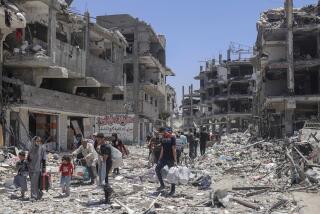Leader of Namibia Rebels Orders Troop Withdrawal
- Share via
WINDHOEK, Namibia — Guerrilla leader Sam Nujoma, in a move that could salvage Namibia’s imperiled independence process, called on his 1,900 soldiers in northern Namibia late Saturday to stop fighting, regroup at U.N. assembly points and withdraw across the border into Angola within 72 hours.
Nujoma’s plea came on the eighth day of bloody battles between his South-West Africa People’s Organization (SWAPO) rebels and South African-backed police and soldiers. At least 289 SWAPO guerrillas and 27 police and soldiers have been killed in the fighting, which began with a SWAPO invasion only hours after the U.N.-sponsored peace plan for Namibia got under way on April 1.
“We have come to this difficult decision because we are aware of the historic responsibility that we have to our people and to humanity as a whole,” Nujoma said in a statement issued from SWAPO’s exile headquarters in Luanda, Angola.
“SWAPO and the Namibian people have nothing to gain by further loss of lives and the collapse of the U.N. independence plan for our country,” Nujoma added.
Nujoma, leader of the 24-year bush war against South African rule here, said the guerrillas should be escorted--with their arms--out of Namibia by the U.N. peacekeeping force here. He called on the force--the U.N. Transitional Assistance Group--to select assembly points in northern Namibia for the fighters.
Nujoma made his appeal as senior diplomats from Angola, Cuba and South Africa began emergency talks under camouflage tents at a safari lodge north of Windhoek in an attempt to end the fighting.
SWAPO was not represented at the talks, and it was not clear what prompted Nujoma’s announcement. But Chester A. Crocker, the U.S. assistant secretary of state for African affairs, and Anatoly Adamishin, the Soviet Union’s deputy foreign minister for Africa, had met with SWAPO officials in Luanda on Friday. Both Crocker and Adamishin were observers at the meetings Saturday.
Nujoma’s orders to his troops came amid increasing international criticism of SWAPO, which had for years enjoyed widespread support outside Namibia. In the past week, the United States and other countries have sharply criticized SWAPO for infiltrating Namibia in what the State Department called “a clear violation” of the agreements that SWAPO had signed.
Under the United Nations’ amended peace plan for Namibia, SWAPO guerrillas were to remain confined to bases north of the 16th Parallel, about 150 miles inside Angola, Namibia’s northern neighbor.
A U.N. resolution, and later accords signed by South Africa, Cuba and Angola, call for SWAPO to remain restricted to those bases in Angola until mid-May, when unarmed guerrillas will be allowed to return to Namibia through entry points monitored by the U.N. peacekeeping troops to participate in the territory’s elections.
South Africa says about 1,900 insurgents, most of them in small groups, remained in northern Namibia on Saturday. Most of the rebels were in thick bush south of a 180-mile stretch of the border.
The guerrillas were being pursued by 3,500 troops and counterinsurgency police officers. Police said that an additional several thousand SWAPO guerrillas were poised just across the border in Angola, and the infiltrations continued Saturday.
Nujoma had maintained that his fighters were in Namibia before the April 1 cease-fire. But the United Nations, as well as the State Department and South Africa, has said SWAPO invaded the territory after the cease-fire began.
Captured rebels have said they were ordered to enter Namibia, many of them in new uniforms and heavily armed, to establish bases. They also said they were told that they would meet no resistance because South African forces were confined to bases and, if they did meet resistance, the U.N. peacekeeping troops would protect them.
Western diplomats say the invasion appeared to have been an attempt by Nujoma to declare his fighters victors and show their supporters that SWAPO’s guerrilla war against South Africa had not been in vain. Nujoma had agreed to the provisions of the U.N. plan earlier this year in a letter to the U.N. secretary general. But he was said to be unhappy with the small role SWAPO leaders played in the negotiations for Namibian liberation.
The SWAPO invasion baffled U.N. officials and diplomats because SWAPO, with substantial support in the north, is considered the likely winner of the U.N.-monitored elections in November. Analysts doubt, though, that SWAPO will obtain the two-thirds majority necessary to write the new constitution by itself.
Under the U.S.-mediated pact signed by Angola, Cuba and South Africa in December, Cuba agreed to withdraw its 50,000 troops from Angola, and South Africa agreed to allow the United Nations to implement its 11-year-old plan for Namibian independence.
That plan, administered by South Africa “to the satisfaction of” the U.N. special representative, establishes a complex timetable for the return of exiles, the beginning of political campaigns and the departure of South African troops here.
But the U.N. plan was threatened on the day it was to take effect when hundreds of SWAPO insurgents streamed into Namibia. U.N. peacekeeping troops based in Angola were to have monitored SWAPO’s compliance, but they did not, for reasons that remain unclear.
To stop the insurgents, the U.N. granted South Africa permission to release 1,500 of its troops from bases to assist police.
The original U.N. plan had called for peacekeeping troops to be stationed along the Angola-Namibia border to prevent infiltrations, but that provision was eliminated when the United Nations reduced its planned 7,500 troops to 4,650 to save money. Wrangling over the cost of the operation also caused a delay in deployment, and fewer than 1,000 of the troops had arrived by April 1.
More to Read
Sign up for Essential California
The most important California stories and recommendations in your inbox every morning.
You may occasionally receive promotional content from the Los Angeles Times.














